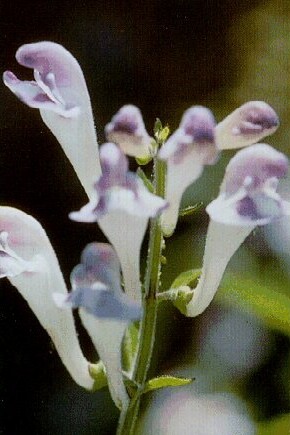Scutellaria montana facts for kids
Quick facts for kids Scutellaria montana |
|
|---|---|
 |
|
| Conservation status | |
| Scientific classification | |
| Genus: |
Scutellaria
|
| Species: |
montana
|
The Mountain Skullcap (Scutellaria montana) is a special plant with beautiful blue and white flowers. People also call it the Largeflower Skullcap. It was first described by a scientist named Alvan Chapman in 1878.
This plant is a forb, which means it's a flowering plant that isn't a tree or a grass. It's also a perennial, so it lives for more than two years.
The Mountain Skullcap is very rare. It only grows in a small area in the southeastern United States. You can find it in parts of Tennessee and Georgia. Because it's so rare, it's protected by the Endangered Species Act. This law helps keep threatened plants and animals safe. The name montana comes from Latin and means "of the mountains," which makes sense for where it lives!
What Does It Look Like?
The Mountain Skullcap plant has a single, straight stem that is square-shaped. It can grow to be about 30 to 60 centimeters (about 1 to 2 feet) tall.
Its leaves grow in pairs, one across from the other. They are shaped like a spear or an egg, with edges that are slightly toothed. Each leaf is usually 5 to 8 centimeters long and 3 to 5 centimeters wide.
A cool thing about this plant is that its leaves feel soft. They have tiny hairs, some of which are sticky (glandular) and some that are not.
The flowers are quite big, measuring about 2.6 to 3.5 centimeters long. They grow at the very top of the stem and are a mix of blue and white. They bloom in late spring, from mid-May to June. The plant then produces its fruits in June and early July.
Scientists can tell this plant apart from other Scutellaria species because its flowers don't have a special ring inside the flower tube. This unique feature helps identify the Mountain Skullcap.
Where Does It Live?
The Mountain Skullcap likes to grow in older forests. These forests are usually full of oak and pine trees. Some common trees it grows near include White Oak, Black Oak, Chestnut Oak, Shortleaf Pine, and Loblolly Pine.
The soil where it lives is often rocky and thin, sometimes only 3 centimeters deep! It's also usually acidic and can be dry or a little bit moist. Other plants that share its home include Desmodium species, Hexastylis species, Spotted Wintergreen, and Flowering Dogwood.
Why Is It Special?
This plant was first listed as an endangered species in 1986. This meant it was in danger of disappearing forever. But good news! More groups of these plants were found. So, in 2002, its status was changed to "threatened." This means it's still at risk, but not as much as before.
Even though its status improved, the Mountain Skullcap still faces dangers. Human activities like logging (cutting down trees), building new neighborhoods (suburban development), and quarrying (digging for rocks) can harm its habitat. Protecting these areas is important to help the Mountain Skullcap survive and thrive.


